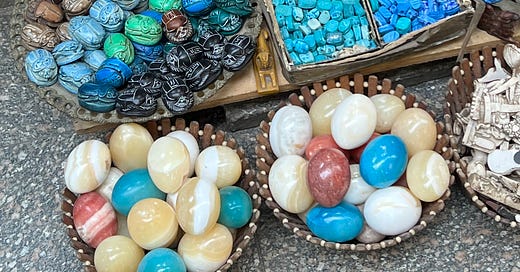29: What did you bring me?
Arguments for—and against—buying gifts on your travels.
“So what did you bring me?”
Millions of kids ask this question when their parents return from trips. The nearly universal query partially explains why airport shops are crammed with “I Love Houston” sweatshirts or chocolates in the shape of Mongolian yurts.
I don’t remember grubbing for souvenir mugs or magnets as a child, maybe because my parents usually took my younger sister Sally and me traveling with them. On the road we used our allowance to buy treasures—a china doll dressed as Martha Washington at Mount Vernon, a rubber python from the gift shop at the Snake Farm, a cheesy reptile house outside of our San Antonio hometown.
But that changed the morning my father Hal arrived home from his first-ever trip to London. In his early 40s, Hal had never been abroad until that spring of 1980, when he traveled to the UK to spend a week collaborating with a fellow political science professor.
He fell hard for the Brits. When he got home, jet-lagged Hal woke his grouchy offspring at dawn to share his enthusiasm. Sally and I walked into the dining room, blearily taking in the buffet of souvenirs spread across the dark wood table. There were T-shirts emblazoned with tall-hatted King’s Guards for us both and a jigsaw puzzle depicting a thatch-roofed cottage in the Yorkshire countryside for me. Best of all were two guinea pig-sized stuffed Paddington Bear dolls in raincoats and floppy hats. They clutched miniature suitcases we knew were jammed with the fictional bear’s favorite orange marmalade sandwiches.
Sally and I were delighted with this Christmas in April, but Hal seemed equally chuffed with the experience. “We’ll go to England as a family next summer, and you’ll see some of these things in person,” he crowed.
Sally, barely six years old, widened her eyes. “Will we get to meet Paddington?”
Why Do We Even Bring Gifts Home?
Dad didn’t buy us those gifts out of obligation along the lines of a “My Parents Went to (insert place here) and All They Bought Me Was this Crummy T-shirt.” He was drumming up enthusiasm for future trips, seeding a curiosity in his children about people and places far away. “I think bringing a gift back from a trip can be about sharing the experience, about giving the recipient a taste of the culture or place,” says Crystal Bailey, director of the Etiquette Institute of Washington.

The concept of conveying people tokens from far away predates recorded history and likely began as a way to broker peace or pay tribute. (Think about those three kings trying to impress baby Jesus with frankincense and myrrh.)
Scientific studies show that presenting a cadeau is as beneficial to the giver (if not more so) as it is to the recipient. “People don’t necessarily want a refrigerator magnet you pick up in Amsterdam,” says Julian Givi, a professor of marketing at West Virginia University who has extensively studied the psychology of gift giving. “But the person giving the souvenir believes that they are being thoughtful.”

Some cultures have a stronger “I came, I saw, I bought you something” tradition. In Japan, omiyage are gifts you bring home from a trip, usually local products—a tin of Osaka rice crackers, a box of Twinkie-like cakes called Tokyo Banana. They’re meant to be shared, not to collect dust or waste away on a shelf. Shops in tourist areas, airports, and bullet train stations specialize in omiyage as well as temiyage, small mementos to use as hostess gifts.
“Japanese people are obsessed with omiyage when they travel,” says Rachel Ng, a Nevada-based writer whose Japanese-born mother introduced her to the concept. “My mom always shops for her friends when she goes places. She spends most of her time in gift shops!”
So Should I Bring a Gift?
If you aren’t Japanese, the answer is “maybe.” If you return home from three weeks in Mexico, and your cousin took care of your cat for free, a “gracias” bottle of tequila or some colorful Oaxacan napkins seem in order.
Visit a destination known for a certain craft (Asheville pottery) or a notable spice (Indian curry), and you might want to stock up on a few mementos to parlay into future hostess gifts. “My grandma would say, ‘don’t show up with your arm swinging,’” Bailey says. “Bringing something small might add to an event, but an item from your travels means a lot more than whatever you picked up by the register at the Wawa.”
I wax and wane on buying gifts when I travel. Giving a friend Peruvian llama alpaca socks or a Murano glass ring from Venice could say, “I was thinking of you” or “I hope you visit this place too.” But of-a-place talismans sometimes signify little to someone who wasn’t along for the Moroccan camel ride or the Grand Canyon hike.
“My grandma would say, ‘don’t show up with your arm swinging,’” says etiquette expert Crystal Bailey.
Back on that 1980s morning, my father’s British gifts inspired a lot of magical thinking. With a little effort I turned my puzzle into a country landscape. And those stuffed Paddington bears became shrunken diplomats, creating a sense of anticipation for two Texas kids who had not yet ventured outside the U.S.
By the time my family hopped a Braniff jet to Heathrow the next summer, Sally and I had made lists of places to visit (Buckingham Palace, a toy museum). And while my father couldn’t introduce us to the “real” Paddington, he took us shopping at Fortnum & Mason, where jars of lime, orange, and lemon marmalade were stacked to the ceiling. Surely our favorite bear had just left the building?









Love the idea of Paddington as a diplomat!
Peeps!